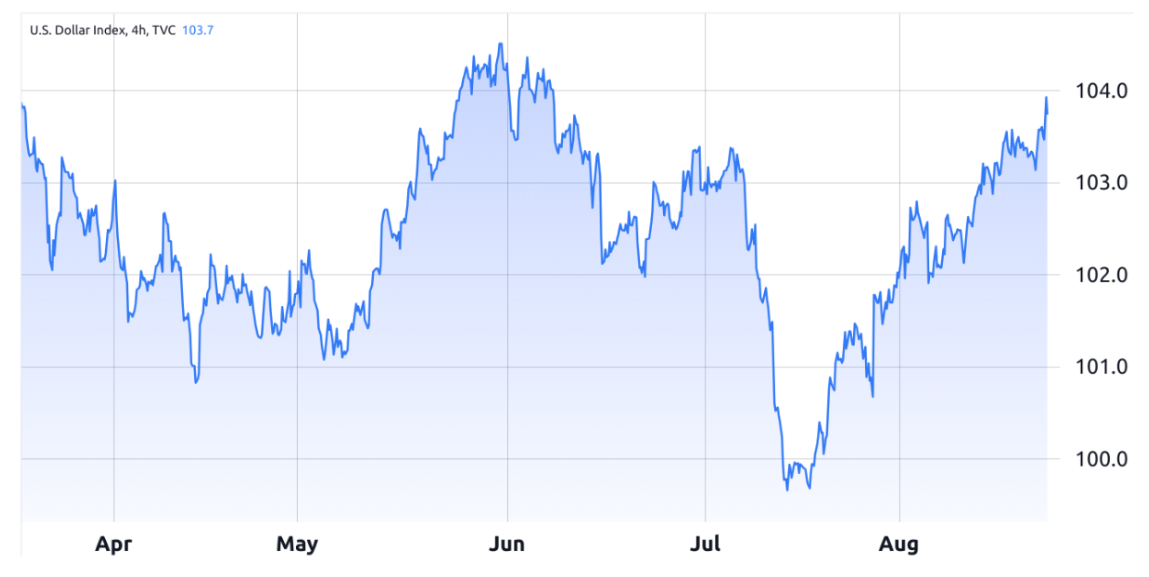The cryptocurrency market has experienced a significant decline recently, with a total market value dropping by 10% between August 14th and August 23rd, reaching its lowest point in over two months at $1.04 trillion. This movement triggered significant liquidations in futures trading, the most since the FTX crash in November 2022. Despite the uncertainties in the global economy, the strengthening of the US dollar has led investors to choose it as a safe haven.
High Interest Rates are Damaging the Crypto Market
Various economic factors contributed to this decline. The increase in interest rates beyond the 5% limit and inflation exceeding the 2% target have raised borrowing costs for both individuals and businesses, putting pressure on consumer spending and economic expansion. This situation means less money is left for savings, which could force people to give up their investments to pay their monthly bills.

Due to expectations of inflation reaching 3.6% in 2024 and average hourly earnings increasing by a record 5.5% annually since 2020, the Federal Reserve is likely to maintain or even raise interest rates in the coming months. As a result, the high-interest rate scenario supports fixed-income investments, which damages the cryptocurrency market.
While inflation has dropped from its 9% peak to 3%, the S&P 500 Index is only 9% below its all-time high. This could indicate a “soft landing” regulated by the Federal Reserve, suggesting a reduced likelihood of a prolonged and deep recession, temporarily weakening Bitcoin‘s role as a hedge.
Factors Stemming from the Crypto Sector
Investor expectations are increasingly focused on the approval of spot Bitcoin exchange-traded funds (ETFs), especially from BlackRock and Fidelity. However, hopes have begun to fade as the United States Securities and Exchange Commission (SEC) continues to delay its decision, citing concerns about inadequate protection against manipulation.
Financial difficulties within the Digital Currency Group (DCG) have also had a negative impact on the market. DCG is struggling with debts exceeding $1.2 billion to its subsidiary, the Gemini exchange. Additionally, Genesis Global Trading, Terra, and FTX recently declared bankruptcy due to losses resulting from collapses. This precarious situation could lead to the forced sale of positions in the Grayscale Bitcoin Trust if DCG fails to meet its obligations.
Another factor exacerbating the market’s troubles is the tightening of regulations. The SEC has made a series of allegations against Binance and its CEO Changpeng Zhao, accusing them of misleading practices and operating an unregistered exchange. Similarly, Coinbase is facing a lawsuit and regulatory scrutiny focusing on the classification of certain cryptocurrencies as securities, highlighting the uncertainty in US securities policy.
US Dollar Continues to Strengthen
Concerns arising from China’s low growth have also emerged. Economists have revised growth forecasts downward for the country, and both imports and exports have declined in recent months. Foreign investments in China showed a decrease of over 80% in the second quarter compared to the previous year. Alarmingly, unpaid bills of Chinese private contractors have reached a staggering $390 billion, posing a significant threat to the economy.
Despite the possibility of a worsening global economy that could potentially increase Bitcoin’s appeal due to its limited supply and stable monetary policy, investors are showing a tendency to flock to the US dollar. This is evident in the movement of the US Dollar Index (DXY), which rose from 99.5 on July 17th to 103.8, reaching its highest point in over two months.


 Türkçe
Türkçe Español
Español









